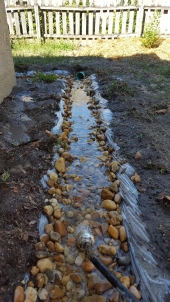John,
I'm still new to this so take what I say with a grain of salt until someone more experienced chimes in.
When comparing conventional agriculture (farms and gardens) with permaculture, it seems like the latter is much more complicated since it requires and understanding of how species interact with each other.
Agriculture period is complicated once you get to the "root" of the matter which is the soil, I think often it just varies in how we approach it. When you start looking at soil composition and structure, cation exchange, pH and nutrient or mineral levels it's all complicated. Conventional agriculture just takes a more narrow, industrial approach to understanding it by adjusting and compensating for these various complexities with methods that in the long term are detrimental, even if short term they are "productive". Conventional ag addresses deficiencies with commercial fertilizers and off farm inputs whereas permaculture seeks to supply the deficiencies in a natural, successive way.
Wheras its very easy to just plant your favorite things in a row next to each other and replant them again next year instead of taking the time to create an ecosystem with symbiotic relationships.
This may be initially true for the short term but in the long term you end up bringing in offsite inputs which increase expense and labor (fertilizer, sometimes commercial compost, lime, etc). So while the backyard garden may produce year after year with truckloads of new topsoil and fertilizer you invariably progress towards some sort of depletion. Permaculture may be looked at as a short term slow starter and labor intensive initially but as natural processes take over and the system produces for itself your workload is lighter, your inputs are minimum to zero (the system provides the needs), and your yield (as compared to the backyard garden when all things are taken into account) ends up being higher.
how would somebody whom knows very little about permaculture realistically begin learning about it and begin practicing.
I started by reading and watching whatever I could find. If you have the dollars to plunk down you could always do a PDC. Alot of understanding comes from observation, good old trial and error. I sat in a chair in my yard and listed out observations. I walked around outside while it was downpouring to observe the water flow. After stuff like that it's researching and planning. I've simplified it obviously but that's the approach I've been able to take without being able to afford a PDC
It doesn't seem like something you could do in your backyard. From what I've seen you would require a large amount of land and a great deal of resources and knowledge to set up a permaculture system. Thoughts?
Geoff Lawton has a video of one of his students with a small backyard that is producing tons of fruit and veg and he has over 30 fruit trees on the site. Permaculture uses a technique called stacking which in some cases is just a functional stacking and in others it mimics the forest canopy...canopy, then trees, shrubs, herbaceous layer, and ground cover, etc. By stacking you load so much more into a small site. Stacking also lets you take advantage of vertical surfaces such as walls, trellises, fences, etc to "stack" your growth vertically instead of horizontally.
I think if permaculture only worked for large sites it would have to just qualify as another "method", it could not answer or help all those urban dwellers without the space. But I have seen many instances where the principles of permaculture were applied to small spaces to great advantage. Remember too, if you've gotten as far as looking at zone and sector analysis, you don't need to implement all 5 zones. A small urban lot may only have 2 zones to it.
Hope it helps, I'll yield the floor to someone with more experience and wisdom







